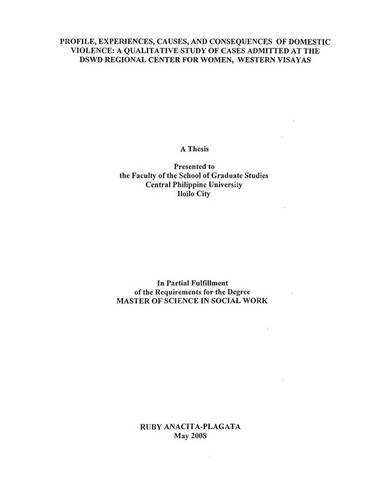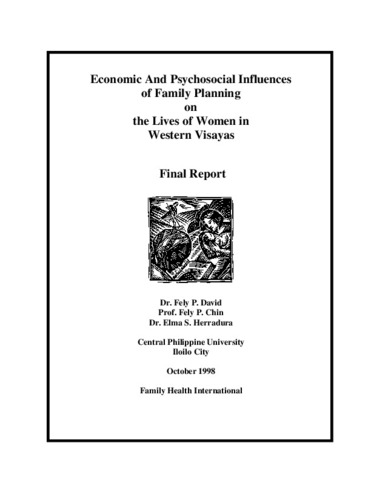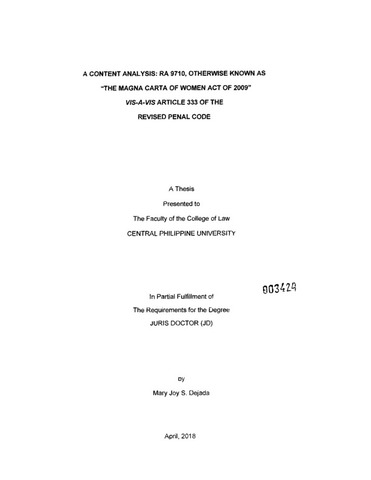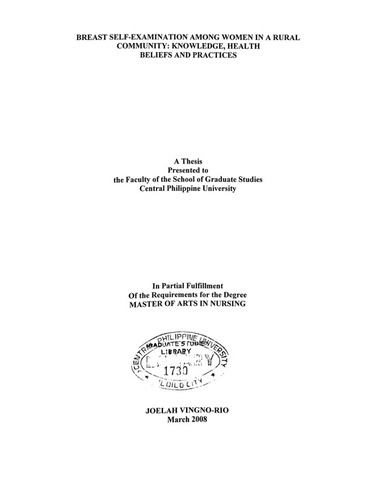Ipakita ang simpleng tala ng item
Profile, experiences, causes, and consequences of domestic violence: A qualitative study of cases admitted at the DSWD Regional Center for Women, Western Visayas
| dc.contributor.adviser | David, Fely P. | |
| dc.contributor.author | Plagata, Ruby A. | |
| dc.date.accessioned | 2021-03-23T01:44:54Z | |
| dc.date.available | 2021-03-23T01:44:54Z | |
| dc.date.issued | 2008 | |
| dc.identifier.citation | Plagata, R. A. (2008). Profile, experiences, causes, and consequences of domestic violence: A qualitative study of cases admitted at the DSWD regional center for women, Western Visayas (Unpublished Master's thesis). Central Philippine University, Jaro, Iloilo City. | en_US |
| dc.identifier.uri | https://hdl.handle.net/20.500.12852/647 | |
| dc.description | Abstract only | en_US |
| dc.description.abstract | This qualitative study on domestic violence attempted to describe the victims of domestic violence admitted at the DSWD Regional Center for Women in Western Visayas in terms of their profile, the types and forms of violence experienced by them, the causes of violence, the perceived consequences of violence and the services they have received from the center and other cooperating agencies. The study covered 34 cases admitted at the center from 2005 to 2007. At the time of the study, there were only seven who were still residing at the center. These seven women, the center staff and a couple of dependents served as the key informants for this study. Profile data and information on their experiences, were derived from center records and other documents available at the center Interview with selected dependents was also conducted. Analysis of the data was purely descriptive. Actual stories and narratives were used as basis for the case studies. Major Findings The data show that of the 34 domestic violence cases encountered by the DSWD from 2005 to2007, the highest number of admission was in 2005 (16). Of the 34 cases, 13 were admitted for physical abuse; 12 for emotional abuse and 9 for sexual abuse/incest. Most of the victims suffered from multiple abuses. The most common perpetrator of abuse among the victims was a husband or a partner. The youngest of the 34 victims was 18 years old, while the oldest was 29 years old. They were mostly unmarried, and poorly educated. Among the identified direct causes of the violence experienced by the clients were: infidelity and jealousy; petty argument and conflict of opinion; vices including alcoholism and drug dependence and nagging and domineering attitude of partner. On the other hand, family history of violence; poverty; lack of education; passivity of women and financial dependence were identified as precipitators of violence. Among the identified physical manifestations of violence are bruises and wounds, which were usually not anymore present during admission. The lasting effects of the abuse, however, usually linger on the psychological aspect which includes trauma and its manifestations. Most of the actions taken for clients of violence were similar in nature which includes a holistic approach to respond to physical, psychological and emotional, legal, social and medical needs but differ on the intensity depending on the nature of the case. Concerned staff prepare individual interdisciplinary rehabilitation plan for each client. Various agencies provide assistance and services to the center residents. These services include professional counseling, livelihood skills training, technical and legal assistances, and basic needs including food, clothing and temporary shelter. Considering their background and experiences, the different victims also have different needs upon admission and also upon release. The most common identified needs upon admission were food, clothing and temporary shelter which the RCW provides. Upon release their need for livelihood was the most prominent. The main problem encountered by the center are: lack of funds for the procurement of vehicle solely for the center’s use and lack of technical personnel. With regards to the perception of respondents on the quality of services received, all of them expressed that they were satisfied with the services provided by the center. This assessment, however, was expressed in the presence of a center staff. Conclusions The total number of cases recorded with the Regional Center for Women is just a small portion of the actual number of domestic violence occurrences. This is due to the fact that cases are underreported, withdrawn from courts or handled by other agencies such as the police, hospitals and other private concerned agencies. Although domestic violence is chronically under reported, research estimates that it accounts for 16 percent of all violent crimes committed. In the 2002 report on violence against women of the National Statistical Coordination Board, physical abuse and battering were the most rampant which comprised the 53 percent. Domestic violence is prevalent among young couples and young people. Similar to other studies, result of this research can lead to the conclusion that abusers are usually male with low educational attainment. In the study conducted by Sung Hye Yu among Korean immigrants, results show that wife batterers tend to be younger, less educated, low income bracket and low occupational categories. Violence against women obviously results from unequal power relations between two sexes. This is based on the theory that frustration often provokes an aggressive response (Zastrow, 1993). This supports the conclusion of this study that the main and primary reason for the occurrence of domestic violence is power and control which is consistent with the framework used in this study. Psychological manifestations of domestic abuse are common among victims though physical traces have vanished during admission of residents. This confirms that psychological scar lingers longer in victims than other effects. The services provided to victims of domestic violence by DSWD and other cooperating agencies may still be limited, but these services at least provide relief to the complicated consequences of the violence which the victims suffer from. The holistic approach to rehabilitation of the victims also prepare them to better integrate in the community upon their release. | en_US |
| dc.format.extent | xiv, 95 leaves | en_US |
| dc.language.iso | en | en_US |
| dc.rights | Attribution-NonCommercial-NoDerivs 3.0 Philippines | * |
| dc.rights.uri | http://creativecommons.org/licenses/by-nc-nd/3.0/ph/ | * |
| dc.subject.ddc | GSL Theses 351.072 P691 | en_US |
| dc.subject.lcsh | Philippines. Department of Social Welfare and Development | en_US |
| dc.subject.lcsh | Family violence | en_US |
| dc.subject.lcsh | Abused women | en_US |
| dc.subject.lcsh | Abused wives | en_US |
| dc.subject.lcsh | Abused women--Services for | en_US |
| dc.subject.lcsh | Abused women--Rehabilitation | en_US |
| dc.title | Profile, experiences, causes, and consequences of domestic violence: A qualitative study of cases admitted at the DSWD Regional Center for Women, Western Visayas | en_US |
| dc.title.alternative | Profile, experiences, causes, and consequences of domestic violence: A qualitative study of cases admitted at the Department of Social Welfare and Development Regional Center for Women, Western Visayas | en_US |
| dc.type | Thesis | en_US |
| dc.description.bibliographicalreferences | Includes bibliographical references | en_US |
| dc.contributor.chair | Pabulayan, Randy Anthony V. | |
| dc.contributor.committeemember | Lariza, Edwin I. | |
| dc.contributor.committeemember | Dusaran, Reynaldo | |
| dc.contributor.department | School of Graduate Studies | en_US |
| dc.description.degree | Master of Science in Social Work | en_US |
| local.subject | Department of Social Welfare and Development (DSWD). Regional Center for Women, Western Visayas. | en_US |






